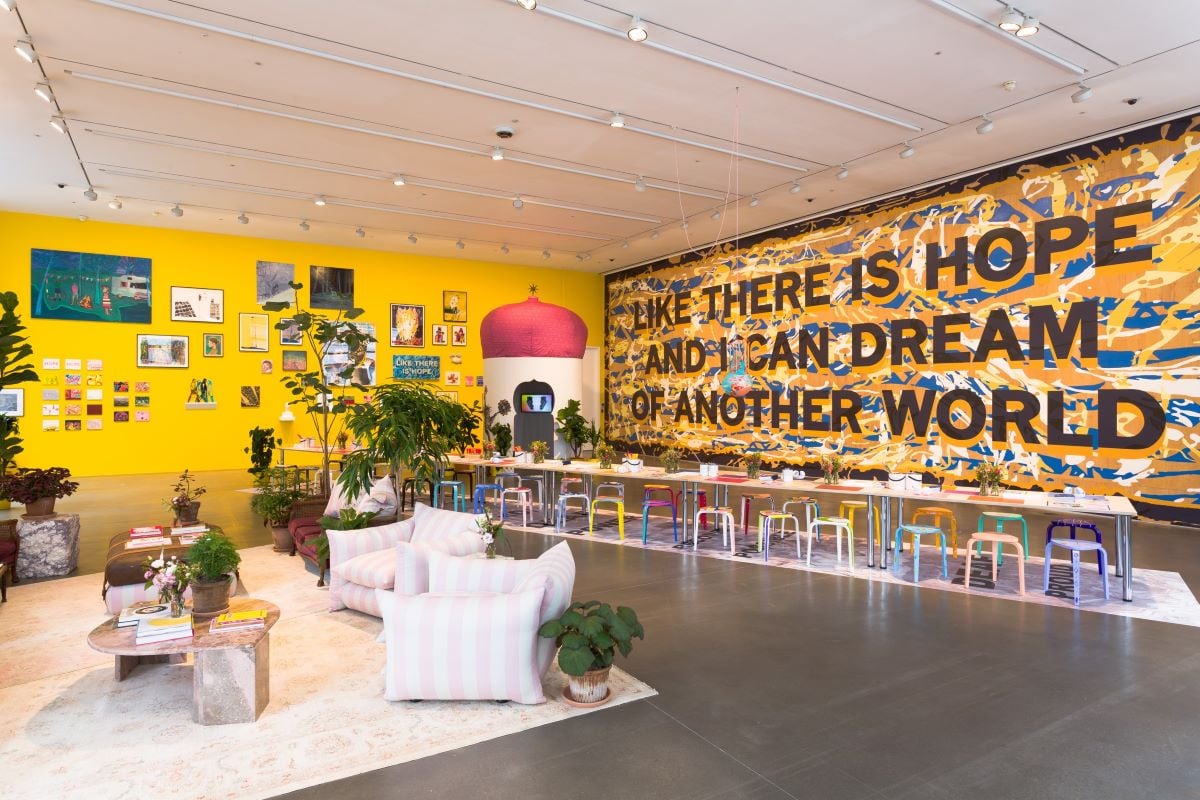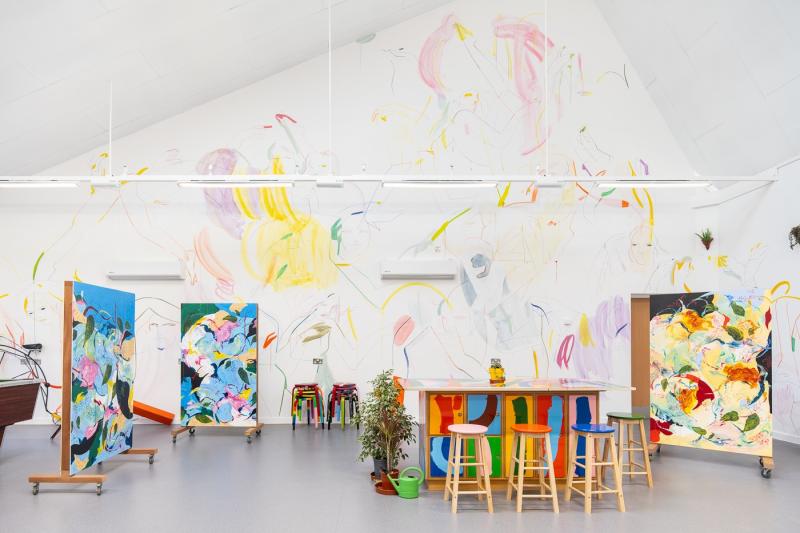
A Hospital Rooms exhibition at Hauser & Wirth London featuring artwork by Mark Titchner, Michelle Williams Gamaker and Harold Offeh among many others.
Spotlight on new NPOs: Hospital Rooms
In the first of this series on new entrants to ACE's National Portfolio, Tim A Shaw and Niamh White share how this is enabling them to contribute more fully to the national conversation around arts and mental health.
In 2016, a close friend of ours was sectioned under the Mental Health Act after attempting to take her life. To keep her safe, she was required to stay in an acute NHS mental health ward. But instead of being a place of hope and healing, it was dilapidated and run down. Surfaces were cold and hard, paint and out-of-date posters peeled off the walls, deafening alarms sounded, doors slammed – it was sensorially hostile.
Sadly, this story is all too common. Care Quality Commission reports, government White Papers, the NHS’s own plans highlight that these spaces are inadequate and not conducive to recovery. Endless testimony from people with lived experiences of these services illuminate this, often demonstrating how they can have re-traumatising impacts on unwell patients.
Conjuring radically new ideas of how mental health spaces could look and feel
We are not the first people to imagine that the arts might have a role to play in addressing this pressing and complex need. It seems an immeasurably common-sense solution to bring artists – people trained in aesthetic quality, materiality and navigation of social structures – together with people with lived experience of these services. Together with clinicians and medical staff they can conjure radically new ideas of how mental health spaces could look and feel. But we are among a small few who have accomplished it, particularly in the most restrictive mental health settings.
After our experience with our friend, we wondered about setting up a project akin to an exhibition. Could we create ambitious and challenging artworks in a mental health setting, engage people in the creative process and influence thinking around what is possible in these institutions?
High risk spaces
It is an understatement to say this idea faced resistance. These are high risk spaces, providing care to people with severe and enduring mental health conditions. Managing serious risk of harm to self and others is an everyday occurrence, and perhaps one of the reasons environments have become as sterile as they are. We were told we would never be able to do this work, qualified through various different reasoning.
At best, we had no evidence base; at worst, we were given generalising and difficult accounts of patients – that they would destroy the artworks or would not be capable of participating. We persisted until one unsuspecting Medical Director, Dr Emma Whicher, gave us our first opportunity at the Phoenix Unit in Springfield Hospital, Tooting, which provides care to people with a diagnosis of schizophrenia, often under section meaning they were not allowed to come and go freely.
Immediately, acclaimed artists wanted to be involved and understood what we were trying to do. With people such as Assemble, Gavin Turk, Nick Knight and others signed up, we secured a small Arts Council England grant.
This was our first foray into public funding, we were beyond naive and completely surprised to have been successful.
Reinventing mental health spaces
As we established a track record for bringing high quality artists into the most challenging mental health settings including Psychiatric Intensive Care and Forensic Services, NHS mental health services began approaching us in droves. Once again, it became apparent that the state of mental health services was compromising clinical teams’ ability to provide care as well as reinforcing negative attitudes and stigma.
We adapted our business model accordingly, now being able to work on an invitation basis, which was supportive from both a financial and delivery perspective. We introduced an application system for NHS Trusts where they needed to demonstrate their own commitment to the projects, including a financial contribution, an allocation of staff time and an interest and capability to support our evaluations.
We have worked with some of the most imaginative, daring and compassionate people in the mental health service (receiving and giving care) and begun collaboratively to re-invent mental health spaces, exploring whether we can introduce spatial qualities that are dynamic, improvisational, tender or sensorial. To discover what conditions might actively nurture creative and participatory instincts in people who have too often been disregarded and side-lined by the arts sector and society at large.
 A refurbished social hub for Northside House, a forensic mental health service at Norfolk and Suffolk NHS Foundation Trust. Artworks were created by FranceLise McGurn, Michaela Yearwood Dan, John Booth and Michael O’Reilly in collaboration with patients.
A refurbished social hub for Northside House, a forensic mental health service at Norfolk and Suffolk NHS Foundation Trust. Artworks were created by FranceLise McGurn, Michaela Yearwood Dan, John Booth and Michael O’Reilly in collaboration with patients.
Validation from becoming an NPO
We’ve only existed in a funding landscape in scarcity mode and have constantly been surrounded by a rhetoric of deficits, challenges and shortfalls. Operating in this context, we’ve built an organisation that’s grown a minimum of 20% year-on-year by developing a range of diversified income streams. Having begun our careers in commercial galleries and adjacent to the worlds of fashion and luxury, we know there is money out there, and being a small team, we need to be extremely selective about where we placed our energy.
Working with ACE from our inception – and other initial funders such as Garfield Weston Foundation and the Baring Foundation – has been fundamental to our development and growth. We have benefited from their wider strategic visions, from adhering to particular reporting systems and from the general validation of attracting these funds. Of course, we advocate for the arts to be more abundantly publicly funded, but we have never seen this as being a viable or likely scenario, and so we have ensured we consistently drive other means of income.
Working with ACE has been fundamental to our development and growth.
Having received numerous project grants, we made our first application to become an NPO last year. We scrutinised the process and implications rigorously to ensure it was something we felt would align with our overall mission and trajectory. We were supported by a huge community to do this – existing NPOs, other funders, wider partners, artists, ACE themselves. In the end, we accepted the offer of around 12% of our overall annual turnover for the coming three years.
This decision was based on the wider support we receive from the Arts Council team, the ability to contribute to the broader conversation nationally around arts and mental health and the organic synergies between our existing values (Compassion, Daring, Sustainable, Quality) and impact work with the Investment Principles and Outcomes.
We have already found the status has contributed to our profile and brand awareness. Two significant funders have recently approached us to give support and it is clear our association with the national portfolio offered them reassurance from both a quality and governance perspective. In addition, we are implementing the various organisational development work in line with the Investment Principles, which has proved supportive of our wider growth.
Wider partnership model
We will continue to push for aggressive growth and scaling of our impact. A core element of this is our partnership with commercial gallery Hauser & Wirth. Through a different kind of three-year commitment, they are supporting us with financial donations, profile raising and access to their community and business development work. It has also provided an opportunity to develop a rich and attractive wider partnership model and to secure additional support with other brands and corporates. The relationship has been one of the most fruitful, collaborative and supportive that we have known.
In the coming years, we have a series of ambitious projects planned. We will be working with architects, Norfolk and Suffolk NHS Foundation Trust and Norwich University of the Arts on a project to build and refurbish five new acute mental health wards, with Cornwall Partnership NHS Trust to transform Bodmin and Redruth Hospitals, and Black Country Healthcare NHS Trust to change the Lodge Road Children and Adolescent Mental Health Service.
We are optimistic about the future and have a strategic plan to bring us closer to our goal of bringing creative and cultural opportunities to all people in need of or using mental health services. While it can sometimes feel overwhelming, we return to Nelson Mandela’s memorable quote: “Everything is impossible, until it’s done.”
Niamh White and Tim A Shaw are Co-founders of Hospital Rooms.
![]() hospital-rooms.com
hospital-rooms.com
![]() @Hospital_Rooms | @NiamhyWhite | @timadamshaw
@Hospital_Rooms | @NiamhyWhite | @timadamshaw
![]() Hospital Rooms
Hospital Rooms
Join the Discussion
You must be logged in to post a comment.